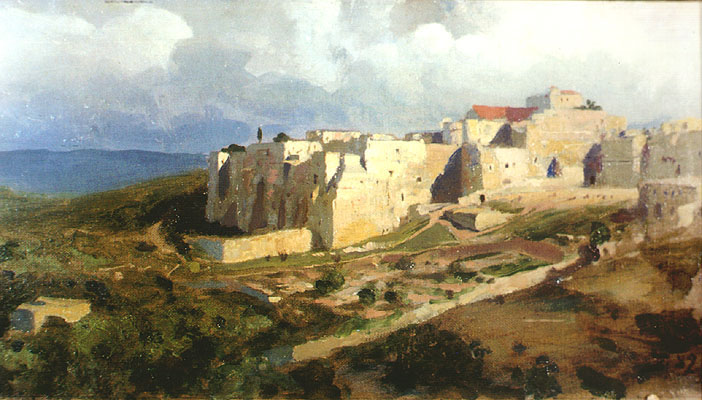
Bethlehem (House of Bread - House of Lahmu) is is a Palestinian city in the West Bank and a hub of Palestinian cultural and tourism industries. It is first mentioned in the Armana letters fourteen centuries BCE. It lies about 10 km (6 mi) south of Jerusalem, standing at an elevation of about 765 m (2 510 ft) above the sea, thus 30 m (100 ft) higher than Jerusalem. The Bethlehem agglomeration also covers the small towns of Beit Jala and Beit Sahour, the latter also having biblical significance.
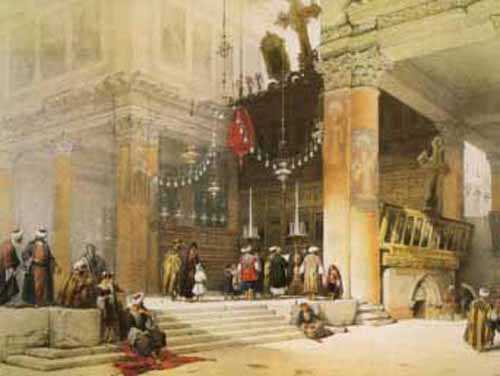
The city has great significance to the Christian religion as it is believed to be the birthplace of Jesus of Nazareth. The traditional site of Rachel's tomb, which is important in Judaism, lies at the city's outskirts. Bethlehem is also home to one of largest Palestinian Christian communities in the Middle East.
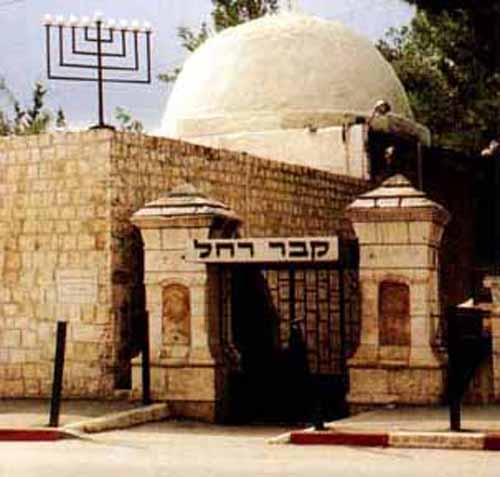
Rachel's Tomb
Bethlehem plays a significant part in the Old Testament, in the history of the Israelites, both before they entered Egypt and slavery, and after the Exodus. It appears in the Old Testament as Ephrat, where Rachel the beloved matriarch of the Jewish People, the favorite wife of Jacob, died during childbirth.
The Tomb of Rachel, is a pilgrimage place for Jews and Muslims alike. Among other Biblical mentions and Holy Sites in Bethlehem: Rachel's tomb, Naomi and Ruth, Samuel anoints King David and the well from which David's warriors brought him waters.
The Church of the Nativity in Bethlehem is one of the oldest continuously operating churches in the world.
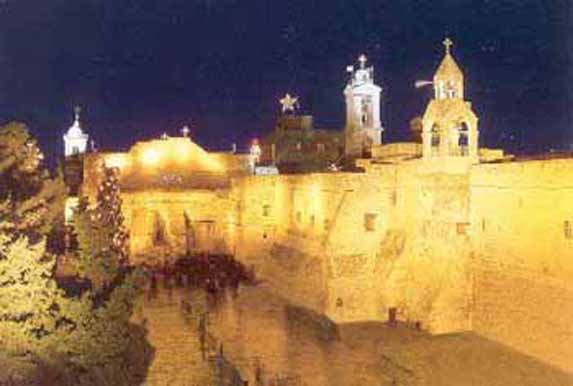
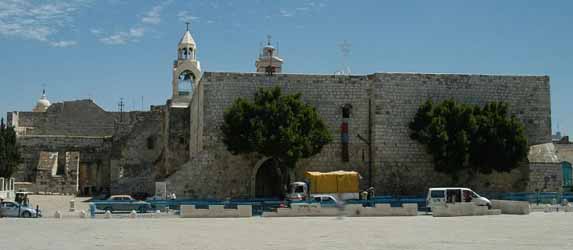
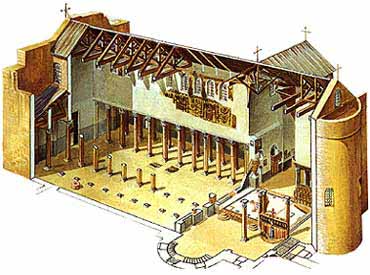
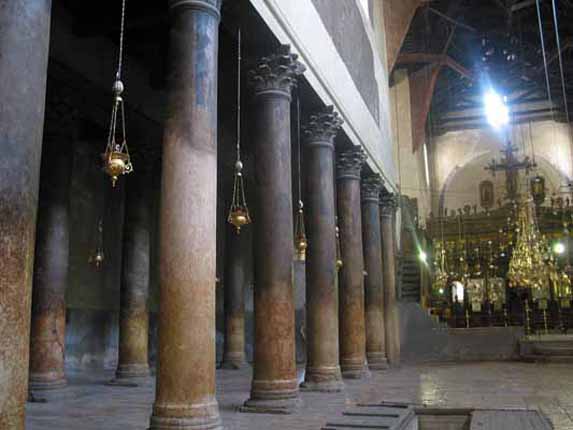
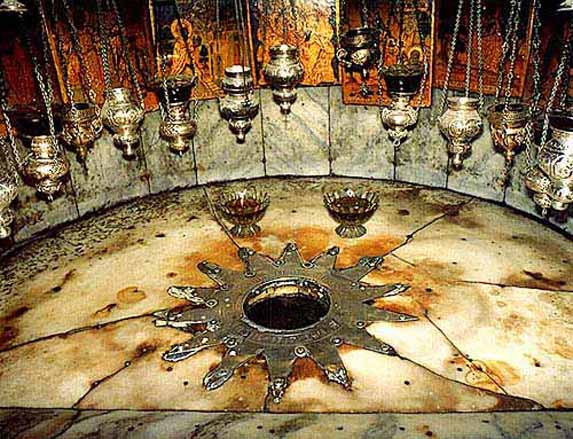
The Manger is situated on the north side of the Grotto, and opposite the Manger, an Alter is dedicated to the Wise Men who came to Bethlehem from the East under the guidance of a star bearing gifts to Baby Jesus.
The original structure was built by Bishop Makarios of Jerusalem at the direction of Constantine I of the Roman Empire following the First Council of Nicaea in 325. That structure was burned down in the Samaritan revolt of 529. It is administered by a coalition of Roman Catholic and Greek Orthodox clerics. Tradition has it that the church was built over Jesus' birthplace, and it is held as sacred by followers of Christianity and Islam.
It is actually a combination of two churches, with a crypt, the Grotto of the Nativity, where Jesus is said to have been born:
- The main section (the basilica) now being controlled by the Greek Orthodox. It is designed like a generic Roman basilica, with three aisles and an apse. It featured golden mosaics covering the side walls, now largely decayed, and a Roman style floor (since covered over). It also features a large iconstasis, and a complex array of lamps throughout the entire church.
- The adjoining Roman Catholic church, which is done in a more modern Gothic revival style, and has since been further modernized according to the liturgical trends after Vatican II.
- The underground cave, which features the altar over the place Jesus is said to have been born. The exact spot is marked by a hole in the middle of a silver star, surrounded by silver lamps. This altar is neutral although it features primarily Armenian Orthodox design.

Today, the vast tracts of pasture land are roamed by flocks of sheep and goats, led by shepherds who wear, now as in the past, severe dark robes and their typical headdress. Against this backdrop events transpired which are recorded in the Scriptures, both Jewish and Christian. The pastures known as the 'Shepherds' Fields' witnessed lives of ancestors of David, the great king of the Jews; and they also witnessed and Angel's Annunciation of the birth of the Son of God to the Shepherds.
Biblical - The city, located in the "hill country" of Judah, was originally called Ephrath (Gen. 35:16, 19; 48:7; Ruth 4:11). It was also called Beth-lehem Ephratah (Micah 5:2), Beth-lehem-judah (1 Sam. 17:12), and "the city of David" (Luke 2:4). It is first noticed in Scripture as the place where Rachel died and was buried "by the wayside," directly to the north of the city (Gen. 48:7). The valley to the east was the scene of the story of Ruth the Moabitess. There are the fields in which she gleaned, and the path by which she and Naomi returned to the town.
City of David - Most importantly, Bethlehem is the birth-place of David, the second king of Israel, and it is also the place where he was anointed as king by Samuel (1 Sam. 16:4-13); and it was from the well of Bethlehem that three of his heroes brought water for him at the risk of their lives when he was in the cave of Adullam (2 Sam. 23:13-17).
Birthplace of Jesus - Since it was distinguished above every other city as the birth-place of "Him whose goings forth have been of old" (Micah 5:2), it was here that, the birth of the Messiah was expected. Accordingly, the gospels (Luke 2:4 and Matthew 2:1) report that Jesus, whom they proclaim as the Messiah, was born in Bethlehem, although he grew up in Nazareth. Matthew reports that Herod, after Jesus's birth had "all the children that were in Bethlehem, and in all the coasts thereof, from two years old and under" killed (Matt. 2:16, 18; Jer. 31:15).
Roman and Byzantine periods
The city was wrecked during Bar Kokhba's revolt (132-135 AD) and the Romans set up a shrine to Adonis on the site of the Nativity. Only in 326 was the first Christian church constructed, when Helena, the mother of the first Christian emperor, Constantine, visited Bethlehem. During the Samaritan revolt of 529, Bethlehem was sacked and its walls and the Church of the Nativity destroyed, but they were soon rebuilt on the orders of the Emperor Justinian. In 614, the Persians invaded Palestine and captured Bethlehem. A story recounted in later sources holds that they refrained from destroying the Church of the Nativity on seeing the magi depicted in Persian clothing in one of the mosaics.
Arab rule and the Crusades
In 637, shortly after Jerusalem was captured by the Muslim armies, the Caliph Umar ibn al-Khattab visited Bethlehem and promised that the Church of the Nativity would be preserved for Christian use.
In 1099, Bethlehem was captured by the Crusaders, who fortified it and built a new monastery and cloister on the north side of the Church of the Nativity. The town prospered under their rule. On Christmas Day 1100 Baldwin I, first king of the Frankish Kingdom of Jerusalem, was crowned in Bethlehem, and that year a Latin episcopate was also established in the town.
In 1187, Saladin captured Bethlehem from the Crusaders, and the Latin clerics were forced to leave. Saladin agreed to the return of two Latin priests and two deacons in 1192. However, the town suffered from the loss of the pilgrim trade. Bethlehem was briefly returned to Crusader control by treaty between 1229 and 1244.
In 1250, with the coming to power of Rukn al-Din Baibars, tolerance of Christianity declined, clergy left the town, and in 1263 the walls of the town were demolished.
The Latin clergy returned to the town over the following century, establishing themselves in the monastery adjoining the Basilica, and in 1347 the Franciscans gained possession of the Grotto of the Nativity as well as the right to administer and maintain the Basilica.
Bethlehem under the Ottoman Empire
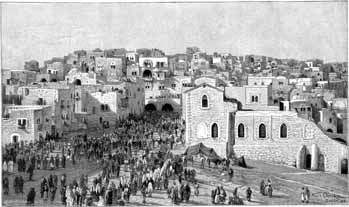
1894
During the years of Ottoman control from 1517 on, custody of the Basilica was bitterly disputed between the Catholic and Greek Orthodox churches.
From 1831 to 1841 Palestine was under the rule of Muhammad Ali of Egypt. During this period the town suffered an earthquake as well as the destruction of the Muslim quarter by troops, apparently as a reprisal for a murder. In 1841, Bethlehem came under Ottoman rule once more, and so it remained until the end of the First World War and the imposition of the British Mandate on Palestine.
20th Century
In the 1947 resolution by the United Nations General Assembly to partition Palestine, Bethlehem was included in the special international enclave of Jerusalem to be administered by the United Nations. Jordan occupied the city during the 1948 Arab-Israeli War. Many refugees from areas captured by Zionist forces in 1947 - 1948 came to Bethlehem, setting up encampments in the north of the city near the road to Jerusalem and on the hillside to the south between the city and Solomon's Pools. These later became the official refugee camps of Beit Jibrin (or al-'Azza) and 'A'ida (in the north) and Deheisheh in the south. This influx of refugees changed the demography of Bethlehem considerably.
Jordan retained control of the city until 1967, when Bethlehem was captured by Israel along with the rest of the West Bank.
On December 21, 1995, Bethlehem became one of the areas under the full control of the Palestinian Authority. It is capital of the Bethlehem district. The current population of the town is about 40,000. The Christian population is no longer the majority, but a special statute requires that the mayor and a majority of the municipal council must nevertheless be Christian.
Recent events
Church of the Nativity Siege
With the escalation of the Israeli-Palestinian conflict, Bethlehem has been the site of many confrontations. In May 2002, during an Israel Defense Forces raid into the city, a number of locals (some of whom were armed) fled into the Church of the Nativity. According to senior Tanzim commander Abdullah Abu-Hadid, the church was specifically chosen due to its abundant supplies of food, water, and as a focal point for international outcry. It became the site of a 5-week stand-off. The number of people inside was estimated between 120 and 240 hostages forbiden to leave the site by at least 40 gunmen. Several groups of civilians were allowed out of the church during the 5 week siege. During the siege several Palestinians inside the church compound were shot dead by Israeli snipers. The siege ended with an agreement for 13 militants to be sent via Cyprus to various European counties and another 26 to be sent to Gaza. The rest were set free. The IDF stated that 40 explosive devices were found and removed from the compound after the standoff was concluded.
Bethlehem, Beit Sahour and Beit Jala are currently surrounded by Israeli checkpoints and roadblocks, with the main road to Jerusalem cut off at the burder of Jerusalem's municipal area - at Rachel's Tomb. Bethlehem residents are only allowed into Jerusalem (the main social, economic and religious centre of the region) with special permits that are usually refused. Travel to other parts of the Palestinian controlled territories of the West Bank is also impeded and sometimes prevented. The city has periodically been placed under strict curfew, preventing residents from leaving their homes. Palestinians are not allowed to enter the Jewish holy site of Rachel's Tomb, which is on the outskirts of the city. Since Bethlehem and the nearby biblical Solomon's Pools lie in Area A, Israeli citizens cannot go there without a permit from the Israeli military authorities.
The construction by Israel of the West Bank barrier has had a severe impact on Bethlehem. The barrier runs along the northern side of the town's built-up area, within metres of houses in 'A'ida refugee camp and the Jerusalem municipality.
Demographic change - Bethlehem's former mayor, Hanna Nasser, says an estimated 2,000 Christians in Bethlehem have emigrated during the period of 2000 - 2003. Fifty years ago, Bethlehem was overwhelmingly Christian. Today, it has a Muslim majority.
Bethlehem, Galilee
Some researchers believe that the New Testament is mistaken on the location of Jesus' birth, and claim that the true birthplace was Bethlehem in the Galilee. The site featured the ruins of a church and a synagogue until the late 19th century, and was found to have archeological evidence of a prosperous city; many scholars place Beth Lehem of Galilee as one of the birth places of Rabbinical Judaism - it is by all accounts a logical place for a spiritual leader with a small group of followers to develop his doctrines. The distance from Nazareth also settles the problem of Jesus crossing the distance between the two cities in six hours according to the New Testament.
Israeli archeologist Aviram Oshri of the Israel Antiquity Authority, who has excavated and mapped the site, found solid evidence of a flourishing Jewish community at the site well before the year 1, and a wall built around the settlement later (though neighbouring Jewish towns never built one). To some archeologists this is a sign of a separatist cult community of some sort, which probably feared the religious wrath of their neighbours rather than more enemies.
In comparison, the Bethlehem area south of Jerusalem has never produced any archeological evidence of a town existing in about 1 AD, until the first Byzantine town in that area some time in the 3rd century. The Judean Bethlehem location was the preferred mythical birthplace of Christ, backing up his lineage to King David.




0 comments:
Post a Comment